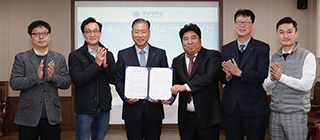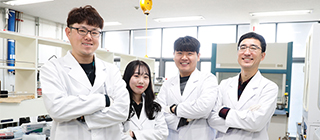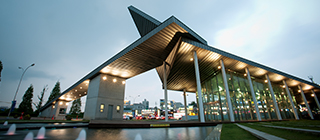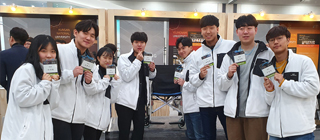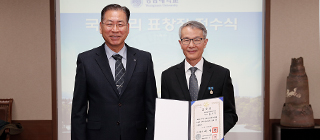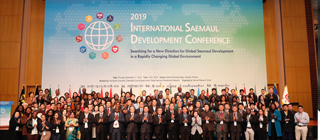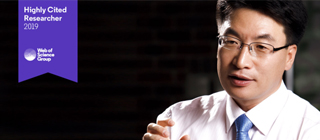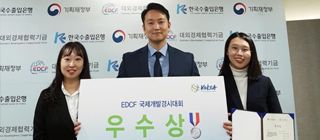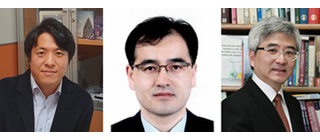-
Food Science and Technology Professor Han Gi-dong develops ‘whitening cosmetic manufacturing technology using persimmon fermented extracts’ Prevention of leukoplakia, freckles... technology transfer wort 110 million KRW with Wizmedi YU supports early commercialization through industry-academic cooperation [December 17, 2019] <The ‘whitening cosmetic manufacturing technology using persimmon fermented extracts’ will be transferred to companies for commercialization> (from left to right: YU Tech Transfer Commercialization Center Director Lee Hee-yong, Food Science and Technology Professor Han Gi-dong, YU President Sur Gil-soo, Wizmedi CEO Choi Yong-hoon, Korea Technology Finance Corporation Daegu Technology Innovation Center Regional Director Choi Gi-jin, Wizmedi co-CEO Han Yoon-soo) The outstanding technologies possessed by YU (President Sur Gil-soo) will be transferred for commercialization. The technology transferred to companies is on ‘whitening cosmetic ingredient compounds’ including persimmon fermented extracts’ developed by YU Department of Food Science and Technology Professor Han Gi-dong. YU signed a technology transfer contract with Wizmedi (CEO Choi Yong-hoon, Han Yoon-soo) on the 10th. This technology transfer signing ceremony was attended by YU President Sur Gil-soo, co-CEOs of Wizmedi Choi Yong-hoon and Han Yoon-soo, Korea Technology Finance Corporation Daegu Technology Innovation Center Regional Director Choi Gi-jin, YU Tech Transfer Commercialization Center Director Lee Hee-yong, and Food Science and Technology Professor Han Gi-dong. At the signing ceremony, YU President Sur Gil-soo stated, “Light is now being shed on the technologies and research capacities of YU by being transferred to a company,” and added, “Through continuous industry-academic cooperation, YU will take the lead in creating new growth engines where the university, companies and communicate can growth together.” YU Tech Transfer Commercialization Center Director Lee Hee-yong said, “The Tech Transfer Commercialization Center will offer continuous support to companies so that it can be commercialized in products early on. The technology being transferred is technology for manufacturing whitening cosmetic products using persimmon fermented extracts, and unlike existing technologies, it is not applied directly on tryosinase and therefore, it can prevent side effects such as leukoplakia and freckles. As the K-beauty industry is growing rapidly in China and Southeast Asia, it is expected that the company receiving this technology transfer will be able to create whitening cosmetic product markets and increase revenue. Food Science and Technology Professor Han Gi-dong, who is the principal inventor of this technology, said, “It is fulfilling to see that research on practical technologies reaped achievements. I hope to continue to contribution to the university, companies and community through research that can be of help to the food and bio industry.” Wizmedi CEO Choi Yong-hoon said, “I would like to thank YU and the researcher for transferring this outstanding research outcome. We will do our best to commercialize it and create an excellent case of industry-academic cooperation.” This technology transfer contract was made through the technological mediation of the Korea Technology Finance Corporation Daegu Technology Innovation Center. With this technology transfer, YU signed a technology transfer contract worth 110 million KRW and it plans to catapult commercialization through product commercialization support. Korea Technology Finance Corporation Daegu Technology Innovation Center Regional Director Choi Gi-jin said, “I am happy to see that through this technology transfer with YU, Wizmedi procured new prospective technologies for commercialization,” and added, “Our center will also do our best to actively support the discovery of outstanding technologies of the university and so that the company can be able to resolve funding difficulties during the technology transfer process.”
-
‘Best Poster Award (Gold)’ at ICAE, an international academic conference in the electromaterials and element technology sector Developed fibers that can be operated by integrating inorganic light emitting diodes Enhanced possibilities to activate the wearable device industry [December 13, 2019] <YU Research Team that won the Best Poster Award (Gold) at the 2019 International Conference on Advanced Electromaterials (ICAE)> (from left to right: Researcher Lee Young-woong, Seo Ji-young, Kim Dong-woo, Department of Electronic Engineering Professor Park Si-hyeon) <?xml:namespace prefix = "o" /> Professor Park Si-hyeon’s (46) research team at the YU Department of Electronic Engineering won the Best Poster Award (Gold) at the 2019 ICAE (International Conference on Advanced Electromaterials). The ICAE holds a large-scale international academic conference encompassing all next-generation electromaterials and element technology sectors. At the 5th international academic conference held at the Ramada Plaza Jeju Hotel from November 5 to 8, researchers from universities and research institutes from 25 countries around the world participated to present over 1,100 of the most recent research outcomes. The study published by the YU research team was titled ‘Integration of LED Arrays onto Textile and Their Individual Control’. The research team coated and processed synthetic resins such as polyester and polyurethane on the surface of fibers to manufacture fibers on which general semiconductor processes such as sputter and thermal deposition is possible to integrate LED matrix on the surface of this fiber in order to configure fine electronic circuits for display and individual control. The leader of this research team, Professor Park, said, “I have been interested on conducting research on light emitting fibers using inorganic light emitting diodes from the perspective of safety and reliability in the fiber electronics sector from long ago. However, there were many difficulties in applying it for industrialization due to difficulties of electronic circuit configuration and precision, as well as low flexibility, etc., and therefore, we focused more on researching and developing light emitting fibers using organic materials.” He went on saying, “Through this research, we were able to integrate inorganic light emitting diodes, which was difficult to configure with past technologies, to develop controllable fibers. The results of this study are noteworthy in that it shows the possibilities for the activation of the wearable device industry.” This study was joined by Professor Park, Graduate School of Electronic Engineering Kim Dong-woo (26, third term in master’s program, photo on right), Seo Ji-young (23, third term in master’s program, photo on right) and YU LED-IT Fusion Technology Research Center researcher Lee Young-woong (38). Kim Dong-woo and Seo Ji-young, who participated as primary authors of this study, finally reaped the fruits from their research since their undergraduate years through the YU Department of Electronic Engineering’s bachelor’s-master’s linked program. Mr. Kim has already been recognized for his research capacities by winning the best poster award at the 2nd Korean LED Optoelectronics academic conference in February. The research team announced its future research plans stating, “We plan to draw up precise electronic circuits inside of fibers through fiber weaving process R&D. We will continue research on the process for creating fibers on which mini/micro LEDs can be applied, which is receiving attention as next-generation displays, and fiber coating.”
-
[2019 Joongang University Rankings] Analysis on thesis citations in international academic journals for the past 5 years Of 8 academic fields, placed first in two fields such as math and computer science [See original article] ▶ https://news.joins.com/article/23639742 [Journalist Kang Hong-joon] It was found that Inje University had high competitiveness in physics, YU in math, and Sejong University in social science and space science. The Joongang Ilbo university ranking team analyzed research competitiveness based on citations of theses published by domestic universities for five years from 2014 to 2018 together with the global academic data analysis company, Clarivate Analytics. During this period, the citations of theses in Science Citation Index (SCI) international academic journals (top 25% academic journals in their respective fields) announced in 22 academic fields such as physics, math, science and clinical medicine. Citations show how many times a thesis is cited after being published and this number can show the impact of a thesis on following studies. Researchers by professors, etc. of Inje University published a total of 150 theses in high ranking academic journals in the physics sector during this period and the category normalized citation impact (CNCI) of each sector for these studies was 5.63. This number means that the impact is about five times higher than the global average (1.0). The impact factor of YU in math was found to be 3.59 and 2.02 for computer science. The research capacities of the provincial private university professors were found be first place among Korean universities, and is higher than the global average. Sejong University also exhibited remarkable achievements in the space science and social science sectors. The impact of theses in Sejong University’s space science sector was found to be 3.15 and the impact factor of theses in social science was 2.74. Comparatively, the impact factor of all domestic universities in the economic and business sectors was found to be below the global average (1.0). During this period, professors of Korea University in the economics and business sectors published 507 theses in international academic journals, taking first place in the number of theses. However, the impact factor of these theses was 0.78. Seoul National University (477, 0.77) and Sungkyunkwan University (350, 0.90) also had many theses, but their impact factors were low. The CEO of Clarivate Analytics Korea said, “In some areas, Korea caught up to Japan in research capacities. However, it seems like the focus is more on the quantity of research rather than quality. The Netherlands, Switzerland and Belgium have much fewer theses than Korea, but their qualitative levels are very high. The focus should be on conducting excellent research in terms of quality, rather than on increasing the number of theses.” ▶ CNCI (Category Normalized Citation Index) An index for evaluating the quality of a thesis. The number of citations in a thesis is the regular value considering the theme, year of publication, and type of thesis. When only talking about the number of citations of a thesis, the characteristics of different academic sector may be overlooked. This is because in some fields, the total number of citations is low and therefore cannot be compared to theses in other fields. Considering the issue that the value of universities with only a few theses would be high, domestic universities with at least 100 theses were analyzed. Sejong University also exhibited remarkable achievements in the space science and social science sectors. The impact of theses in Sejong University’s space science sector was found to be 3.15 and the impact factor of theses in social science was 2.74. Comparatively, the impact factor of all domestic universities in the economic and business sectors was found to be below the global average (1.0). During this period, professors of Korea University in the economics and business sectors published 507 theses in international academic journals, taking first place in the number of theses. However, the impact factor of these theses was 0.78. Seoul National University (477, 0.77) and Sungkyunkwan University (350, 0.90) also had many theses, but their impact factors were low. The CEO of Clarivate Analytics Korea said, “In some areas, Korea caught up to Japan in research capacities. However, it seems like the focus is more on the quantity of research rather than quality. The Netherlands, Switzerland and Belgium have much fewer theses than Korea, but their qualitative levels are very high. The focus should be on conducting excellent research in terms of quality, rather than on increasing the number of theses.” ▶ CNCI (Category Normalized Citation Index) An index for evaluating the quality of a thesis. The number of citations in a thesis is the regular value considering the theme, year of publication, and type of thesis. When only talking about the number of citations of a thesis, the characteristics of different academic sector may be overlooked. This is because in some fields, the total number of citations is low and therefore cannot be compared to theses in other fields. Considering the issue that the value of universities with only a few theses would be high, domestic universities with at least 100 theses were analyzed.
-
<Creative Comprehensive Design Contest> ’Grand prize’ beating 145 teams from around the nation <Smart Car Simulation Hackathon> ‘First Prize’... Received engineering education innovation meritorious person medal [December 6, 2019] <YU ‘Challengers’ team that won the grand prize in the 2019 Engineering Festival ‘Creative Comprehensive Design Contest’ sector> YU (President Sur Gil-soo) swept the awards winning the grand prize and first place prize. At the ‘2019 Engineering Festival’ held at the Songdo Convensia in Incheon on the 26th and 27th of last month, the YU ‘Challengers’ team that took part in the ‘Creative Comprehensive Design Contest’ won the grand prize, thus receiving the Minister of Trade, Industry and Energy Award. The ‘Challengers’ team is a multi-disciplinary team centering on the YU College of Mechanical and IT Engineering with Bae Sung-ho (23, junior), Bae Hyung-chang (23, junior) and Cho Hwan-jin (23, junior) of the School of Mechanical Engineering, Kim Ji-hwan (24, junior), Jang Joo-eon (23, junior) and Koo Gyo-in (22, junior) of the Department of Information and Communication Engineering, Seo Myo-sung (21, junior) of the Department of Psychology, and Lee Da-bin (19, sophomore) of the Department of Visual Communication Design. They submitted their work called the ‘Smart Module for Safe Wheelchairs’ in this contest joined by 145 teams around the nation, and took home the grand prize. The ‘Challengers’ team applied the concept of Internet of Things (IoT) in the simple mechanical drive part of existing wheelchairs and received high assessments for upgrading it to a smart everyday device. There were many creative ideas from engineering students around the world such as in the fields of electric/autonomous cars, IoT home appliances, robots, bio-health, aviation/drone, etc., drawing huge attention. At the ‘Smart Car Simulation Hackathon’ operated by the YU Engineering Education Hub Center at the Engineering Festival, the YU team including Jung Jin-ho (25, senior) of the YU Department of Computer Engineering took first place and received the Korea Institute for Advancement of Technology Award. The ‘Smart Car Simulation Hackathon’ is a contest for changing the structure of the vehicle or producing an engineering-optimized racing car using automobile mechanisms, data analysis, and racing simulation AI. <YU wins first place at the 2019 Engineering Festival ‘Smart Car Simulation Hackathon> Furthermore, YU Engineering Education Hub Center Director Song Dong-joo (Professor at the School of Mechanical Engineering, first on left in photo below) and researcher Ryu Mi-jung (second from left) were selected as meritorious persons for engineering education innovation and received the Minister of Trade, Industry and Energy award. They were recognized for not only fostering creative engineering human resources, but also developing and operating programs reflecting industrial demands technological changes. <Engineering education innovation persons of merit medal awarding ceremony> YU President Sur Gil-soo said, “This was made possible by constructing systematic engineering personnel fostering programs, while operating the engineering education hub center for many years.” He added, “Engineering students are important human resources who will lead the future industries of the nation. YU will continue to work hard to foster convergent human resources with various knowledges in their majors that will lead the age of the fourth industrial revolution.” Meanwhile, the 2019 Engineering Festival sponsored by the Ministry of Trade, Industry and Energy and co-hosted by the Korea Institute for Advancement of Technology and the Engineering Education Innovation Association is an event designed to foster engineering personnel who will lead the next-generation convergence industries and was joined by over 10,000 people from 102 universities in both Korea and abroad.
-
Contributions in spreading and developing Saemaul Undong for developing countries through Saemaul education, improving the international reputation of Korea Education and research of the Saemaul training program in link with KOICA... Provided plans to apply ‘Saemaul’ in developing countries [December 3, 2019] YU Park Chung Hee School of Policy and Saemaul Dean Kim Gi-soo (61, photo on right) received the Prime Minister’s medal. He was recognized for his contributions in improving the international reputation of the Republic of Korea by spreading the Saemaul Undong to developing countries, thereby providing a cornerstone for the development of developing countries. Dean Kim Gi-soo served as the vice-dean of the Park Chung Hee School of Policy and Saemaul from February 2014 and took the position of dean from February 2017. Dean Kim has been teaching the theories and experiences of rural development and economic development based on the Saemaul Undong of Korea for international students from developing countries. Dean Kim has been active not only in the graduate school programs, but also with research and education activities in connection with other institutes such as KOICA and YU Institute for International Development Cooperation. Dean Kim has been sharing the Saemaul Undong and Korea’s economic development experience by planning the Saemaul Training Program for public employees of developing countries and non-government organization development experts, and has been passing on knowhow for plans to apply the Saemaul Undong for developing countries. Meanwhile, YU established the Park Chung Hee School of Policy and Saemaul to foster global Saemaul leaders for developing countries in November 2011. Unlike international students in regular undergraduate and graduate schools, international students at the Park Chung Hee School of Policy and Saemaul are made up of public employees, employees of public institutes, social activists, and professionals who plan and execute policies in their nations. This program graduated 593 students from 63 countries around the world including from Asia, Africa, Europe and the Americas, and the graduates are taking the leading in spreading Saemeul Undong and local social development in their home countries.
-
Majored in ‘textile design’ at the Department of Living Products Design in undergraduate and graduate school Living products including clothes and bags applying weaved textile designs First place after competing with students, general public and designers [December 5, 2019] <YU Graduate School of Living Products Design Kim Hyun-jung won the grand prize at the 2019 Daegu Industrial Design Expo> Miss Kim Hyun-jung (26, master’s degree in textile design) from the YU Graduate School of Living Products Design won the grand prize at the 2019 Daegu Industrial Design Expo. Works were submitted to a total of four areas such as visual design, industrial craft, product and environment design, and service design at the Daegu Industrial Design Expo, and Miss Kim submitted her textile design product in the industrial craft sector. Undergraduate, graduate students, amateurs and professional designers submitted their works in this expo to compete with each other. The works were received from October and after the preliminary reviews, a total of 17 made it o the finals where the final reviews were held on November 28. The 17 participants held presentations on the intent and techniques of their works, and in result, Miss Kim’s work took first place. The pieces submitted by Miss Kim were titled ‘Sentences in Time 2019’ (photo on right). The textile designs produced by weaving were applied in the clothes, bags, wallets, and tablet PC cases in these product designs. Miss Kim’s works were put on display at the ‘Design Week in Daegu 2019’ held at the Daegu EXCO. Miss Kim graduated from the YU Department of Living Products Design in February 2016 and in September of the same year, she went on to the master’s degree course at the YU Graduate School and is scheduled to graduate in February of next year. Miss Kim has been recognized early on for her knack and skills as a designer. She was selected as an outstanding artist in the ‘2016 DNMD Young Creative Korea’ and participated in special exhibits, and last year, she won the participation prize at the 49th Gyeongsangbuk-do Industrial Design Exhibition Award and special award at the 37th Daegu Design Exhibition Award. In November, she held her first solo exhibit based on her research results and works gained by majoring in textile design at the Daegu Gallery J One. Miss Kim said, “After graduating in February of next year, I plan to study a bit more abroad. I want to study weaving in more depth.”
-
International academic conference held to search for a new direction for global Saemaul development in a rapidly changing global environment Joined by over 250 scholars, experts and development sector public employees from 23 countries [November 21, 2019] <The 2019 International Saemaul Development Conference was held at the Daegu Interburgo Hotel on the 21st> The 2019 International Saemaul Development Conference was held at the Daegu Interburgo Hotel on November 21 under the theme, ‘Searching for a New Direction for Global Saemaul Development in a Rapidly Changing Global Environment’. This international academic conference co-hosted by YU (President Sur Gil-soo), Cheongdo-gun and the Global Saemaul Development Network (hereinafter GSDN) was joined by over 250 people including scholars, experts and public employees in the development sector from 23 countries. This academic conference was made up of a total of four sessions with different topics and a general session, and discussions on practicing the Saemaul spirit and the effective application of the Saemaul development model for developing countries in Asia and Africa were held. In his keynote address, YU President Sur Gil-soo emphasized, “The biggest driving force behind Korea being able to come out of absolute poverty and become an advanced industrial nation was the Saemaul Undong. The reason why Korea was able to become an economic powerhouse with national income of 30,000 USD was because of the ‘Saemaul Undong’ that spread from rural areas to cities and from the homes to work.” President Sur added, “YU has continued to conduct research and education on the Saemaul Undong from the mid-1970s until now and many professors and researchers centering on Professor Choi Wae-chul are working hard to spread the Saemaul Undong to developing countries and to solve common issues of the global community.” He also stated, “It is necessary for us to recognize the need for Saemaul Undong to play a leading role in resolving the common issues of the global community and as the president of YU, I will spare no effort or support for this.” Meanwhile, GSDN Chairman Choi Wae-chul said, “Through the advancement of science technologies, the labor of humans can be replaced by machines and therefore, it will be possible to use the surplus time more valuably.” He gave meaning to this academic conference saying, “This is a gathering for thinking about and working on a safer and happier life for not just me and us, but for everybody.” YU has continuously worked on becoming equipped with the best infrastructure for education and research for the Saemaul Undong. YU began research on the Saemaul Undong from the 1970s and opened the Park Chung Hee Leadership Research Institute (currently Park Chung Hee Saemaul Research Institute) in 2009, Saemaul Research Center in 2010, Park Chung Hee School of Policy and Saemaul (PSPS) in 2011, and the Department of Saemaul and International Development in 2015 to construct the academic foundation for the Saemaul Undong. Meanwhile, Cheongdo-gun, which is known to be the place where the Saemaul Undong first originated, signed an MOU with YU in 2011 to install and operate the Saemaul Research Center. It not only holds the International Saemaul Development Conference, but is also actively engaged in globalization of the Saemaul Undong in countries like the Philippines and Vietnam to lead the global Saemaul Undong. The Global Saemaul Development Network (GSDN), which is one of the co-hosts of this academic conference, is a non-government international organization launched as a foundation in 2015 and it is leading the formation of pan-global networks to share the experience of Saemaul development. It currently has over 500 individual and institutional members in 65 countries. YU, Cheongdo-gun and GSDN has been holding the International Saemaul Development Conference every year, and this conference is playing a leading role in global Saemaul development. In the four sessions with different themes for this academic conference, cases of applying Saemaul development in different regional development fields such as in Asia (Bangladesh, Vietnam, Indonesia, Cambodia) and Africa (Ghana, Rwanda, Uganda, Zimbabwe, Kenya, Tanzania) were introduced. Furthermore, case-studies on improving the environment for international students at YU were also presented. Meanwhile, in the general discussions hosted by PSPS Dean Kim Gi-soo, Governor Abuya Karim of the Sumunep Regency in East Java, Indonesia, Dr. Martin Dinha the president of the Zimbabwe Railroad Corporation and former minister of state, Gyeongbuk Techno Park President Lee Jae-hoon, and PSPS Vice Dean Jung Jin-young held discussions on applying global Saemaul development and to search for a new direction in international development cooperation according to the rapidly changing global environment. Zimbabwe National Railroad Corporation Martin Dinha said at this academic conference, “I was very impressed with the Saemaul Undong and the economic development of Korea, and we gained many implications for the development of infrastructure such as railways.” YU Saemaul Research Center Director Park Seung-woo that hosted this academic conference said, “Despite huge amounts of development aid being poured in, most development aid did not have meaningful outcomes in many of the developing countries, and so a new conceptual framework is needed for international development cooperation.” He also stated, “The core element of the Saemaul Undong is development based on the assertive participation and self-helping efforts of residents,” while adding, “(this academic conference) will provide a good lesson on how effectively the Saemaul development model is at regional development sites in various countries such as Asia and Africa, and for the global Saemaul development program.”
-
‘Top 1% in thesis citation ranking’ in the three fields of computer science, engineering and mathematics Only 11 researchers in the world selected for three fields... Only person in Korea Professor Park’s former student, Chonbuk National University Professor Lee Tae-hee also selected in top 1%, passing down research capacities [November 20, 2019] YU Department of Electrical Engineering Professor Park Joo-hyun (51) was selected as the world’s top 1% researcher for the fifth consecutive year. In addition to the mathematics sector for which he was selected every year since 2015, he was also selected as the top 1% in the world for computer science and engineering as well. There are only 11 people in the world selected in the top 1% of the world in three or more fields. He is the only one to have achieved this feat in Korea. This shows that even among global researchers, he is recognized for his unparalleled research capacities. The global information analysis service company, Clarivate Analytics (hereinafter called Clarivate) announced the list of the ‘2019 most influential researchers in the world, otherwise known as ’the top 1% researchers in thesis citations (highly cited researchers, HCR). There were 6,216 researchers from over 60 countries around the world listed in this year’s HCR. There were a total of 41 researchers selected for HCR in Korea, and 39 of them were Korean citizens. A total of four researchers including Professor Park were selected in two or more fields. HCR are selected from a total of 22 fields including 21 fields in the science and social science fields and one cross field (cross field, researcher with high influence in various research fields). One point worth noting is that 18 researchers from Korea were listed in this year’s cross field, and Professor Lee Tae-hee of the Chonbuk National University Department of Electronic Engineering, who was a student of Professor Park Joo-hyun, was also listed. Professor Lee earned his bachelor’s, master’s and PhD at YU, while completing his post-doctorate studies at Deakin University in Australia, and finally being appointed as a professor of Chonbuk National University in September 2017. He trained at Professor Park’s lab, which became the cornerstone for him to grow into a world-renowned researcher. Clarivate analyzes the ‘Web of Science’, which is known to be the world’s largest academic information database, to select the most highly cited papers (1%) in each field. This means that the quality of the paper is outstanding. There are a total of 23 Nobel Prize winners including this year’s Nobel Prize winner Gregg L. Semenza of Johns Hopkins University (Nobel Prize in Physiology or Medicine), John B. Goodenough of the University of Texas (Nobel Prize in Chemistry), and Esther Duflo of MIT (Nobel Prize in Economics) in the HCR list.
-
Graduate students of the Department of Saemaul and International Development recognized for research capacities in the international development cooperation field Gained capacities as experts in common issues of the global community [November 19, 2019] <YU Graduate School of Saemaul and International Development students won second place at the 8th EDCF International Development Contest> (from left to right, Seo Eun-ji, Choi Han-ul, Lee Jin-ri) YU Graduate School of Saemaul and International Development students won second place at the ‘8th EDCF International Development Contest (thesis contest)’ held on November 11. The Economic Development Cooperation Fund (EDCF) International Development Contest is a thesis contest held for domestic and foreign college and graduate school students in order to elevate awareness on Korean official development aid for the younger generation and is hosted by the Ministry of Economy and Finance, which oversees the EDCF, and the Export-Import Bank of Korea. A total of six teams area awarded based on creativity and the possibility for proposing international development cooperation policies through screening in preliminaries and the main contest. The YU Graduate School of Saemaul and International Development team (Adviser Park Seung-woo) comprised of Choi Han-ul (33, second term in PhD program), Seo Eun-ji (23, second term in master’s course), and Lee Jin-ri (22, second term in master’s course) won second place. They presented their paper on the theme of <Donor-Recipient Private Partnership Loan (DRPPL) for development in the private sector>. This study investigated the outstanding development models in the private sector by advanced contributing nations. After conducting analysis using research hypotheses on theories related to strategic partnerships between companies, which has been pointed out as a limitation, it proposed a new type of loan model to expand the spectrum of Korean loan aids, thereby drawing attention. In particular, it was judged that this research paper has high value to be utilized for international development policies by the international community. Meanwhile, Choi Hyun-gyu (24, second term in master’s course) of the YU Graduate School of Saemaul and International Development, who also participated in the contest by teaming up with other graduate school students, also won a participation prize. Also, students of the YU Department of Saemaul and International Development were recognized for their enhanced understanding on official development aid (ODA) by participating in the ‘EDCF college (graduate school) student camp’ hosted by the Export-Import Bank of Korea and for establishing global cooperation strategies (CPS), thus winning first and second place. Global Saemaul Development Network Chairman Choi Wae-chul (Professor at the YU Department of Saemaul and International Development) said, “As Korea has developed from a recipient to a contributor, it is important to strive to return the gratitude for receiving aid in the past back to the international community. From this aspect, the meaning of this EDCF International Development Contest, which is a program for fostering academics that share the Korean experience according to the features of developing countries, is very special.” He added, “In the case of Korea, free aid is mainly provided by KOICA, while loans are mainly overseen by the Export-Import Bank of Korea (EDCF). I hope that YU students, who are acknowledged for their capacities in the international development cooperation sector, will continue to build their capacities as experts of common issues for the global community.” The YU Department of Saemaul and International Development is a special academic department that turned the Saemaul Undong, a UNESCO Memory of the World, into a science with the goal of overcoming poverty in developing countries and fostering human resources for the international development cooperation sector. Students and graduates of the department are selected for various internships such as overseas volunteer corps and international organizations, or participate in various domestic and overseas ODA (official development aid) projects or international development activities.
-
Configured anti-bacterial material plug-in manufacturing method with high bacteria-resistance and low risk to humans Ultra-fine antibacterial hazards evaluated within 3 weeks... Presenting humidifier disinfectant, microdust hazard standards Joint research by Professors Byeon Jung-hoon (Mechanical Engineering) and Kim Jong-oh (Pharmacy) with Yonsei University [November 18, 2019] <from left to right, YU School of Mechanical Engineering Professor Byun Jung-hoon, School of Pharmacy Professor Kim Jong-oh, Yonsei University Department of Mechanical Engineering Professor Hwang Jung-ho> YU and Yonsei University conducted joint research to develop a method to quickly evaluate the hazards of ultra-fine substances such as microdust and humidifier disinfectants. Professor of Mechanical Engineering Byun Jung-hoon and Professor of Pharmacy Kim Jong-oh from YU and Yonsei University Mechanical Engineering Professor Hwang Jung-ho worked together to configure a method to manufacture anti-bacteria mineral nanoparticles under hundreds of nanometers (nm) in the form of microdust (aerosol) using a plug-in system. They also devised the method to evaluate the harmfulness to the human body for such ultra-fine anti-bacterial substances within three weeks. This paper was joined by Gautam Milan (PhD course) of YU and Park Dae-hoon (PhD course) of Yonsei University as co-first authors. The results of this study are receiving a great deal of attention due to the rapidly growing microdust in the atmosphere, the humidifier disinfectant incident that caused a social uproar, and growing concerns on harmful substances in the air. In particular, due to concerns on the harmfulness of silver (Ag) and copper (Cu) nanoparticles that are the most well-known anti-bacterial substances, they are being restricted by law for being used industrially such as in air filter coating substances, etc. The research team stated, “We discovered the fact that by partially doping copper, which is a metal with very good anti-bacterial properties, in tellurium (Te), which is a metal known to be less harmful to the human body, it was possible to maintain anti-bacterial properties, while significantly lowering harmfulness to the human body.” They added, “Using this property, we successfully configured the platform to easily produce 200nm or lower safe anti-bacterial nanomaterials by simply plugging in.” The research team also devised an evaluation method for verifying the functionality of safe anti-bacterial nanomaterials in the form of microdust and harmfulness to people within three weeks. Results of evaluating this newly developed substance showed that there was high anti-bacterial properties and low harms to the human body for evaluations inside and outside of the body. Professor Byun Jung-hoon said, “Using this evaluation method, it has become possible to evaluate the hazards of mineral nano anti-bacterial materials within a relatively short period of time. It has become possible to set a new standard on whether existing or new anti-bacterial materials are truly safe.” He added, “Through follow-up research, it will be possible to play a big role in coming up with a solution to ease the national concerns on microdust, humidifier disinfectants, etc.” Meanwhile, this study was conducted with the support of the National Research Foundation’s basic research project (backbone researcher and leading research center support project). The research results have been published in the acclaimed international academic journal published by the American Chemical Society ‘ACS Nano’ (impact factor 13.903) recent online issue [https://doi.org/10.1021/acsnano.9b04939 (study name: Plug-In Safe-by-Design Nanoinorganic Antibacterials)].
